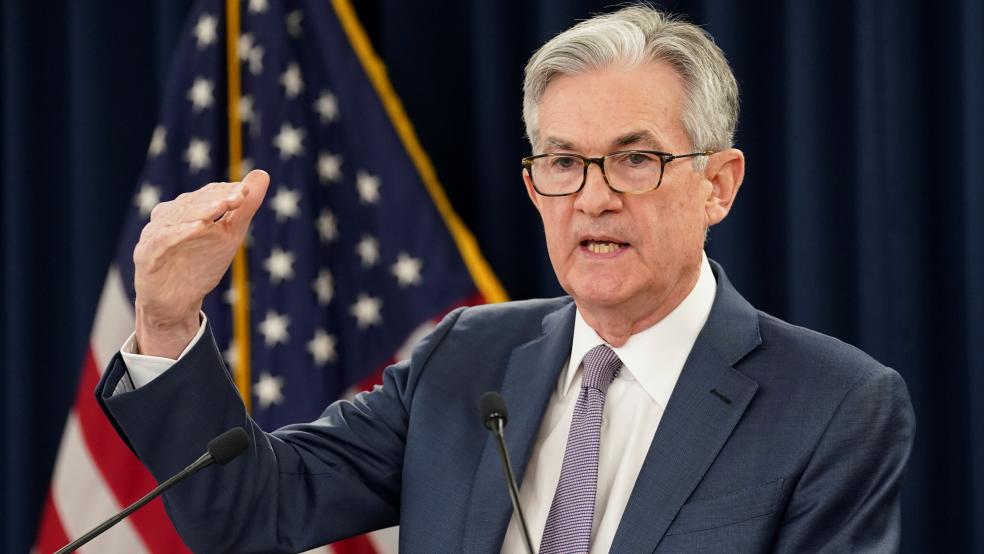Faced with a choice between maintaining its effort to restore price stability and providing some breathing room for the struggling banking sector, the Federal Reserve opted to press ahead in its war on inflation, raising its benchmark interest rate by a quarter point Wednesday, to a range between 4.75% and 5.00%.
Fed Chairman Jay Powell told reporters that the Federal Open Market Committee had considered pausing its rate increase campaign due to recent bank turmoil, but strong economic data, as well as confidence in the soundness of the banking sector, persuaded the committee to remain focused on the threat of inflation.
Assessing the economy, members of the FOMC said they see “modest growth in spending and production,” with job gains still “running at a robust pace.” Inflation, they said, “remains elevated,” with Fed officials remaining “highly attentive to inflation risks.”
Turning to the banking system, which has been rocked by a handful of recent failures, officials noted that the financial turbulence over the last 12 days has likely produced additional monetary tightening, which could help slow the economy and control inflation. “The U.S. banking system is sound and resilient,” the FOMC statement said. “Recent developments are likely to result in tighter credit conditions for households and businesses and to weigh on economic activity, hiring, and inflation.” Just how powerful those tightening effects will be, however, remains “uncertain.”
Looking forward, Fed officials said they expect to raise rates again, though perhaps not as much as they had expected to before the recent bank problems. “The Committee anticipates that some additional policy firming may be appropriate in order to attain a stance of monetary policy that is sufficiently restrictive to return inflation to 2 percent over time,” they wrote, notably removing the phrase “ongoing increases” from its post-meeting statement. The FOMC’s latest projections indicate one more rate increase, to an average level of 5.1% – significantly lower than the 5.5% level many analysts had expected to see as a potential peak rate.
Powell said it is not yet known whether the uncertainty in the banking system will produce enough credit tightening to help reduce the inflation rate. If it does, the Fed may end up raising rates less than expected. If, however, significant credit tightening does not occur, then the Fed may have to raise rates more than expected.
“Financial conditions seem to have tightened,” Powell said. “We’ll be looking to see how serious is this and does it look like it’s going to be sustained. And if it is, it could easily have a significant macroeconomic effect, and we would factor that into our policy decisions,” he added.
What the experts are saying: The 25-basis-point rate was widely expected, and the Fed’s short-term outlook jibes with that of many analysts. “The Fed’s actions today are consistent with our long-held view that the Fed will raise rates to 5.125% and pause for an extended period,” Jefferies economist Thomas Simons said in a note. “Barring an increase in contagion risk within the banking sector, we expect that the Fed will be faced with a very similar policy decision in May, and they will be compelled to deliver another hike.”
David Russell of TradeStation told CNBC that recent bank failures probably mean that the Fed will ease up sooner than previously expected. “Bank runs have done the Fed’s job for it,” he said. “The Fed acknowledged off the bat how credit conditions have tightened, which could reduce inflation. They also toned back the commitment to aggressive rate hikes. This is a net positive for sentiment because it puts the Fed back in wait-and-see mode instead of an all-out tightening campaign.”
RSM chief economist Joseph Brusuelas said the FOMC’s projection of a peak benchmark rate of 5.1% implies that “we are at or close to peak policy.” The credit tightening rippling through the market due to bank stress is roughly equivalent to another 50 basis points in rate hikes, indicating to Brusuelas that the Fed’s “policy is now restrictive.”
That restrictive stance, combined with the ongoing risk of further troubles in the banking sector, seems to be pushing some analysts toward a more pessimistic outlook on the economy and the markets, with investors sending stocks tumbling late Wednesday as they processed the Fed’s latest moves. “The probability of the Fed sticking the landing on this without causing a recession, increasing unemployment, and preventing further consolidation in the domestic banking sector would appear to be quite low,” Brusuelas said.



